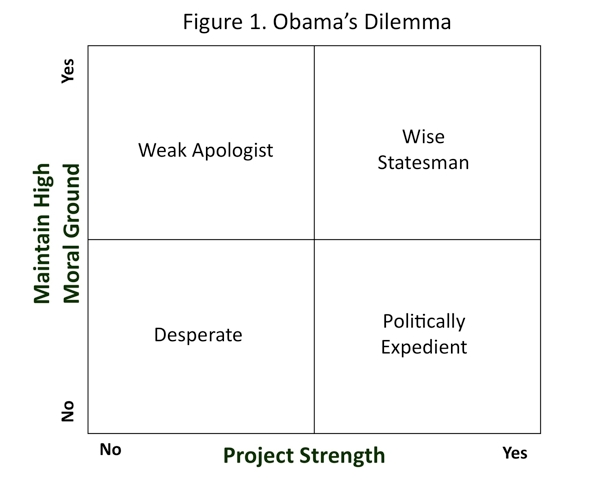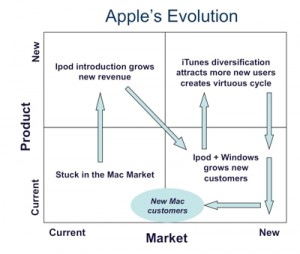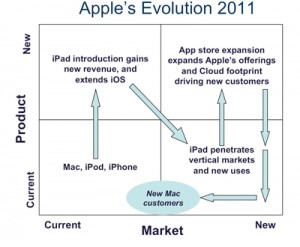Last week’s presidential debate exemplified a core dilemma for each of the presidential candidates (…we couldn’t help but notice). The GOP badly needed Romney to come across as presidential, human and credible, without abandoning his conservative values and position. Challengers must prove they belong in the office. Obama needed to hold onto the moral high ground of civility and respect while communicating strength and the ability to win battles. In this case, that meant exploiting conspicuous weaknesses in his opponent’s recent performance.
Put another way, Romney had to tone down some of the most conservative positions he took during the primaries, in order to effect a believable shift to the middle. This could be seen as crafty campaigning or craven pandering, what is referred to in a New York Times editorial this Saturday as The Moderate Mitt Myth and by John Cassidy in the Financial Times as Mitt 2.0. Obama needed to step out of his own shadow and take a few risky swings at the ball. In this contest, waiting for the other guy to mess up won’t be enough to win; you have to define and sell your platform.

How did the candidates do in the debate and in managing their respective dilemmas? And from a dialectical perspective, what do they need to do for the next debate?
There is little question about who won the debate – Romney came out roaring and Obama could not locate his mojo. What happened? As dangerous as analogies can sometimes be, try this one. It’s a boxing match, but only one fighter is throwing punches…Romney of course. The other guy has been trained in the higher martial art forms, and is waiting for his opponent to get reckless in his aggression so he can capture and turn his energy against him. He has done his homework and knows that the other guy always does this. Trouble is, in this fight, his adversary has done even better preparation than him. He lands blow after blow without losing his composure or creating any openings. The fight ends with one bruised fighter still waiting for his chance to throw a punch. Interestingly, this is how many Republican primary debates ended as well, with Romney’s enemies not really landing hard blows.

The Next Challenge
Entering the second debate there are new questions about the President and the challenger as well. Will Obama’s second round debate performance be enough to counter suspicions that he is at heart more a very smart theoretician than the man of action leader America desperately wants and needs? Can Mitt continue to hold conflicting positions without being forced to explain how x and not x can coexist?
From a dialectical point of view, what advice can we offer? Barack, your opponent is stretching the limits of personal credibility by wanting it all – keeping the Republican core happy while convincing significant numbers of women, Hispanics and other non-traditional voter groups that he really does care about them and that they should trust him. Force him to take a public stand on tough issues: that will prove difficult if not impossible.
Mitt, you have the momentum, and the Prez is limping. The nation is indeed in rough shape, and whatever the reasons for it (really, who cares at this point?), progress on key issues has been limited. Force Obama to choose between hiding in the high ground (and thereby convincing voters he is all promise and no action), and jumping into the muck of bare-knuckle fighting and name-calling (compromising his pristine image). Whatever you do, don’t allow him to successfully straddle the two positions.
Someone Will Pay
It is no secret why both candidates are somewhat mute on articulating sharp policy positions, and prefer to paint their opponent’s views as ineffectual or reckless. The US economy faces tough choices. Policy options like raising taxes, lowering deductions, cutting spending, tightening benefits, and pursuing various economic stimuli, all invoke fervent opposition. Someone will have to pay, and both candidates hope to persuade voters that future pain will be borne by someone else. But the debate about what really comes next is one Americans need to have.

How Do We Win?
So here’s another 2 x 2 take on what may happen in the upcoming debate. One candidate is on his game and the other is not. There is a clear winner, but perhaps, just possibly, the electorate has been manipulated into their beliefs, and their opinions will lack the balance that we hope shapes outcomes.
It is possible that both candidates get it terribly wrong, and we watch a messy exchange that does not enlighten or inform. And finally, maybe, if we are lucky, they will both come prepared, focused, able and willing to truly debate the issues in a way that lets voters know them and their respective positions. Perhaps we are being naive in believing a series of debates can sway opinions enough to matter, but history suggests it has happened before: remember Nixon and Kennedy in 1960! Informed democracy, it’s possible. Wouldn’t that be sweet!
SEND COMMENTS TO ALOWY@SYMPATICO.CA
Comments
October 17, 2012. The phrasing attempts to put a light touch on a serious subject, which is refreshing, but the dilemma axes seem to me to miss the core dilemmas facing the candidates.
For Obama, ‘Maintain High Moral Ground’ versus ‘Project Strength’ do NOT pose a dilemma. Not projecting strength is not a real option in any political battle.
At the end of the piece ‘Romney On His Game’ vs ‘Obama On His Game’ do NOT pose two horns of a dilemma. They may pose alternative scenarios … also, the middle ground on both axes is a high possibility.
If you revise, here are some suggestions. The debates are about domestic policy on the one hand and foreign policy on the other. The real dilemmas for Obama might be… how to keep highlighting Romney’s weakness on foreign policy (where he is weak) even if the question is about domestic policy (where he is stronger), or, how to convince the electorate that they should care about foreign policy when they mostly care about jobs and the domestic economy.
These examples attempt to identify dilemmas involving content, not style …
–Tom Emodi
October 17, 2012. Tom, Thanks for taking the time to share your thoughts; vigorous challenge is more than fine by me. In fact, it’s the hallmark sign of the dialectical process working!
Our goal with every 2 x 2 modeling exercise is to explore an essential aspect of a complex situation in a way that sheds new light and informs action. Last night’s debate reflected multiple points of tension between the candidates. The three we presented in this post certainly showed up. (So did the one you propose in your note). Speaking specifically to them,
1. Obama’s dilemma of Moral Ground versus Projecting Strength…much of the debate was about his ability to achieve this balancing act. Morning-after reports are giving the president high marks on exactly this – the Benghazi incident proved to be a pivotal flashpoint in the debate.
2. Romney’s dilemma of Reaching out to Non-traditional Voters versus Maintaining his Conservative Base…Obama pressed him on this throughout the debate, and post hoc assessments are that Romney lost some important ground with women voters.
3. On their Game or not…I’d say both candidates came ready to rumble, and the electorate witnessed an engaging and informative exchange.
What makes these dilemmas? You raise a good question here. It’s a dilemma when there is tension between forces and when there are meaningful costs and trade-offs involved in choosing one option over the other. So, does Obama put his presidential persona at risk by being aggressive? I believe so. Does Romney stand to lose one constituency by courting the other? Yah. Is there risk to each of the candidates coming ready to battle hard? Might they be tempted to draw in their horns, risk less in the hopes of avoiding any irretrievable gaffes? Sure they would.
-Alex Lowy
October 16, 2012. I agree with your assessment of the response. I agree most definitely with the writer that the redistributive, communitarian, liberalist model offered by Obama is not deeply in American DNA, but I also have to note that there have been periods of crisis and perceived crisis when Americans looked to the governance model of activist government to reorient the American trajectory. I cite three examples: Lincoln, Teddy Roosevelt, FDR — the middle one being fodder for debate. A counter-model is Stevenson’s losses in ’52 & ’56. Social liberalism did not trump national security during the nervy years of the Cold War.
The question will turn for Obama on whether enough Americans still believe in his vision of government as an instrument of social cure (read: social liberalism). He cannot count on a second lightning strike; the hope’n’change election of 2008 will not be subject to redux. America is deeply divided and Obama still has many voters in his corner. But does he have enough?
Where I will beg to differ with the writer is re: Romney. I think he’s right to pan the absence of a unified worldview, although to be brutal about it, mainstream Americans are in no position to connect the dots of any grand theory. My disagreement stems from this observation:
“Romney’s fundamental problem Is that he really is the corporate CEO, who can afford to have no core values or beliefs whatsoever – just outstanding skills at reading the environment, developing an approach to accomplish goals and then solving problems as they arise. That is why he is hard to nail down and often seems contradictory.”
I think there’s virtue-of-necessity to be made here. A deep vein in the American political psyche that can always be mined to advantage is pragmatism. What works is good. Now let’s find someone who has a plan to make things work. Romney does not need an integrated, highbrow network of conceptually calibrated and integrated ideas. He needs “solutions” to problems. He needs to make thing work. And that’s where Mr. Hopey-Changey failed. All the big-brain atmospherics are as nothing with the American electorate without solutions. Back to Lincoln, TR & FDR…each was an active solver of problems. No deep ideological constructs or high-minded visions (Wilson & Carter). Romney can speak directly to the aching heart of America not by saying: “I feel your pain” but by saying: “I’m a pain-dissolver. Let’s get busy with practical, pragmatic solutions.”
In the VEEP debate, where Biden sabotaged himself with a parade a ghastly visuals, there were observable carrots in the test group response meter (CNN) every time certain words were thrown out. These spikes seem to me to be associated with words like “solution”, although “solution” is the one that I remember vividly. I thought: There it is. Americans are hurting. They’re not looking for ideological models. They don’t care of the cat is black or white. They need a cat that will mouse successfully. And this is where Romney can position himself as solutions guy — keeping in mind that solutionism can be hard, tough work. There are no packages with pretty pink ribbons. Hard decisions will have to be made but…”I’m the guy to make them”. Obama is very vulnerable to this presentation because he’s the incumbent and it appears that most Americans feel he’s had a lackluster 1st term. Therefore, the killing question is: Does President Obama merit a second term? Has he showed us enough of that sleeves-rolled-up American pragmatic get-it-done-ism to deserve re-election? Since the answer to that question is “no” or “hmmmm, not really”, then the next question is: “Why not give Mitt a chance? Why not vote Republican for president but vote Democrat is House & Senate races to hedge the bet?”
Obama and Biden may have already beaten themselves. Romney’s best chance now is to look presidential, look fresh and energetic, talk about solutions, hard work, the challenge ahead, challenge the American people to do what they’ve always done: rally, and not beat himself by tumbling into one of the many bear traps that will be laid out for him (abortion, war with Iran, intervention in Syria and a possible confrontation with Russia).
—Stu Wooley
October 16, 2012. Just read your article on the dilemmas of the debate. I see both candidates on exactly the same strategy with the electorate – the Jack Nicholson Few Good Men strategy: “The truth! The truth! Son, you can’t handle the truth!” Unfortunately that is the only strategy that seems to work for anyone now running for office.
Your analysis was, I thought, both thoughtful and incisive. My own sense is that each candidate also faces a larger issue.
Romney’s fundamental problem is that he really is the corporate CEO, who can afford to have no core values or beliefs whatsoever – just outstanding skills at reading the environment, developing an approach to accomplish goals and then solving problems as they arise. That is why he is hard to nail down and often seems contradictory. That is why the base has never trusted him. Tom Friedman, on Charlie Rose the other night, made a good observation. He said, “You could interview me for two hours on the Middle East and I would never contradict myself, because I would answer each question on the basis of my overall unified view of the region, and not need to remember a long list of specific answers to specific questions.” He heavily implied, and I think he’s about right, that since Romney has no unified worldview, he is taking each question as it comes and on its own terms.
Obama, on the other hand, faces the problem that, while in my judgment he does have a core view of an American future, if he laid it out clearly, he would make Dukakis look like “Landslide Mike.” He has a very communitarian view – the government’s role is to level results despite differences in talent, work and virtue. This is not what built America, it will not solve our problems, indeed it will worsen them, and in any case it is not remotely in synch with American voters, beyond the ethnic minorities, who believe in the government as benevolent redistributor based on their historical experience of civil rights legislation.
I know there are some who argue the opposite – that in fact Obama is exactly like Romney in the “no core beliefs” model, only instead of the CEO problem solving model, he is in the group facilitator model. You may recall me talking about a distinguished psychiatrist who studied political personality and psychology. His rule of thumb for understanding world leaders was “Understand their first professional success and their first professional failure, for they will spend the rest of their lives trying to duplicate that first success and avoid that first failure.” In that regard, Obama’s first professional success was being elected editor of the Harvard Law Review. What few people know is that he was elected on something like the seventeenth ballot, after being no one’s choice. The leftist (critical legal studies) guys and the right (The Federalist Society) guys, who were warring armed camps but both without a majority, deadlocked the process for the first 16 votes. Obama supposedly during this process established himself as without a strong view and thus the two sides finally gave up the fight for supremacy and elected him. They assumed they would at least get a hearing from Obama, which they would not if the “other side” was elected. If that psychiatrist is right, perhaps we really do have two candidates without a core.
Oh yes, you are sunnier about the Nixon-Kennedy debates than I. The only news from that debate is that visuals win every time regardless of substance. In many ways, the visuals of the first debate killed Obama, and the visuals of Biden weren’t much better. So of course the consultants are both coaching their guy, “ Don’t worry about what you say, just win the visuals!”
We’ll see. Increasingly I think we won’t find a real leader until we hit the debt wall sometime in the next several years. And worse, we then run the risk that the type of leader who arises in that situation is often not a very attractive proposition!
–Rich Lauf
October 16, 2012. Rich, Loved your response. You remain my favourite cynic! Bar none. Why, because you are willing to get informed and you have a big heart.
–Alex Lowy
We love our heroes. We hate to see them fall, but when they do, they fall twice as hard. Lance Armstrong’s achievements as a cancer survivor, competitive athlete and fundraiser place him in a rare class of his own. Revelations that he (may have) cheated to win, and pressured his teammates to do the same, are disconcerting. Graced with remarkable talents, it feels tragic to us that he would succumb to a desire to win at any cost. Dilemmas abound in this case, for Lance Armstrong himself, for the professional cycling world and the bodies that oversee it, for the charitable organization founded by him to raise money to fight cancer, and finally, for fans who find themselves torn, not knowing whether to criticize him for such a moral lapse or stand by him for his courage, accomplishments and contributions. Let’s take a look at a few of these.











